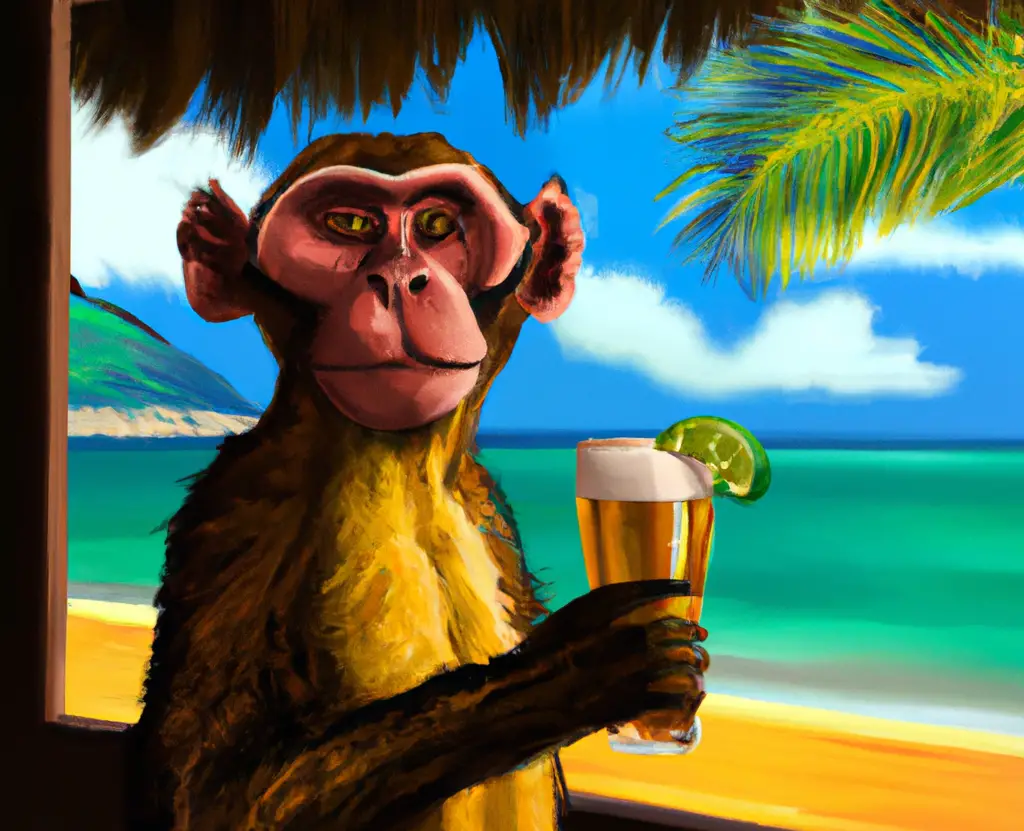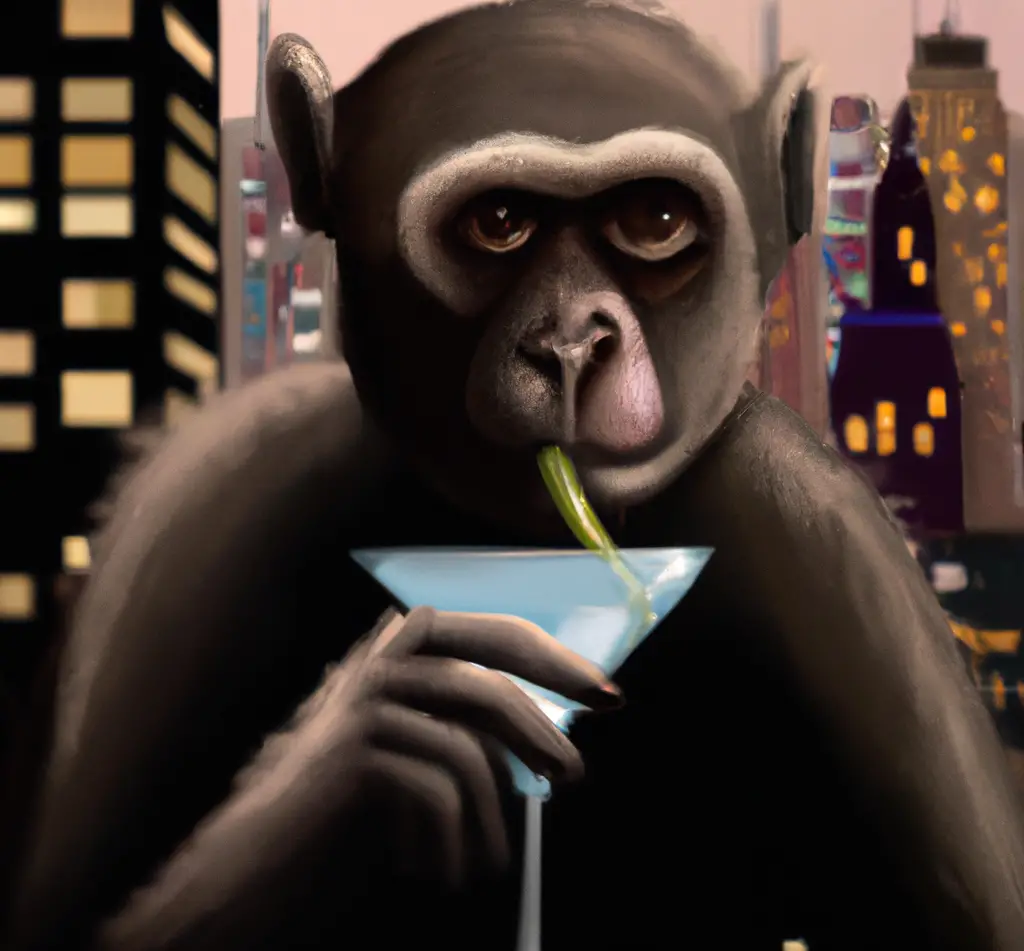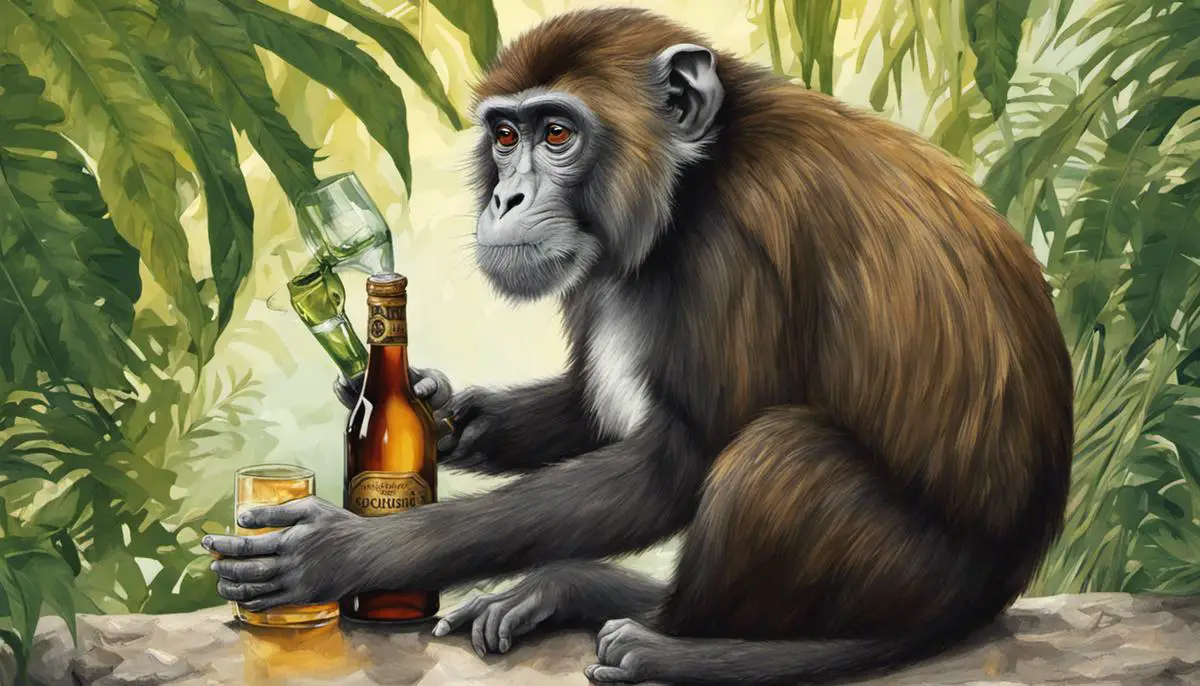In the rich tapestry of life on Earth, humans are not the only creatures partaking in the consumption of alcohol. Monkeys, along with other animals, have been found to indulge in the sweet allure of fermented fruit and in doing so, exhibit fascinating behavioral changes. Exploring this occurrence allows us to understand not only the influence of monkey alcohol consumption on their bodily functions, social interactions, and cognitive abilities but also broadens our perspective of cross-species alcohol consumption. As these observations accumulate, the potential implications for human drinking behavior may surprise you.
Let’s Monkey Around With Booze
Behavioral Effects of Alcohol on Monkeys

Understanding Alcohol Consumption in Monkeys
Monkeys are a member of the primate family, much like humans. These animals have been utilized in various scientific studies due to their closely related genetic makeup to humans. One of the research areas includes studying the effects of alcohol consumption. This investigation can give significant insights into the behavioral modifications and physical responses occurring when monkeys drink beer or other alcohol-infused substances.
Alcohol’s Impact on a Monkey’s Behavior
Behavioral changes are commonly associated with alcohol consumption. Monkeys under the influence of alcohol display a variety of behaviors, ranging from social alterations to cognitive shifts. For instance, some monkeys may demonstrate increased aggression, while others may become more passive or sociable. The role of dominance in the social structure of monkey groups can significantly impact how alcohol influences their behavioral responses. Dominant males might consume more alcohol as a means of demonstrating their status, leading to drastic behavioral shifts.
Cognitive Impairments from Alcohol
The cognitive impacts of monkey alcohol consumption are often pronounced. Drinking alcohol can lead to decreased attention spans, hindered learning capacities, and impaired memory functions. Just like humans, monkeys show signs of a blackout, unable to recall events that transpired while intoxicated. Significant cognitive dysfunction has been observed in monkeys subject to prolonged periods of heavy drinking, similar to the effects of chronic human alcoholics.
Physical Effects of Alcohol on Monkeys
Aside from affecting social and cognitive behaviors, alcohol can also take a physical toll on monkeys. They may experience a decline in motor functions, including impaired balance and coordination, resulting in clumsiness or inability to perform tasks requiring fine motor skills. Long-term consumption leads to liver damage, similar to the cirrhosis seen in human alcoholics. Moreover, monkeys drinking alcohol have also shown notable weight loss and general physical deterioration over time.
Patterns of Alcohol Consumption among Monkeys
Research has identified patterns in the way monkeys consume alcohol. Monkeys self-administer alcohol in a way that’s strikingly similar to humans, highlighting the genetic similarities between the two species. Some monkeys choose to consume large amounts of alcohol in short periods – mimicking binge-drinking behaviors seen in humans. Conversely, some monkeys completely abstain from alcohol consumption, again mirroring human reactions to alcohol exposure.
Exploring the Scientific Significance
Monkeys, given their close genetic kinship with humans, are an invaluable asset for exploring the effects of alcohol. By observing their consumption patterns, as well as the behavioural, cognitive, and physical changes they experience, scientists can get a deeper understanding of the complexities of human alcohol addiction. This critical analysis could potentially pave the path for enhanced prevention and treatment methods for alcohol-related disorders in humans.
Alcohol Consumption in the Animal Kingdom

Understanding Alcohol Consumption in the Animal Kingdom
The occurrence of alcohol consumption is not an unfamiliar sight in the natural world. Evidence points back to our early human ancestors who might have ingested alcohol in the form of fermented fruits. Typically, when ripe fruits fall from trees and start to decay, the sugars they contain undergo fermentation, turning into alcohol. Certain creatures, notably monkeys, bats, and elephants, are documented to eat these fermented fruits, thereby ingesting alcohol in their diets.
Monkey Alcohol Consumption Is Common
In primates, notably monkeys and apes, alcohol use has been recorded in both captive and wild environments. The exact reasons for this behavior are not clear, but it is a widely observed phenomenon. In fact, a species of monkeys living on the Caribbean island of St. Kitts have been observed to steal tourists’ drinks to get their alcohol fix. These monkeys prefer sweet alcoholic beverages, which are quite similar to ripe, fermented fruits.
In a noteworthy experiment from the 1990s, monkeys had access to a concoction with an alcohol content similar to wine. Most monkeys drank only in moderation, but a significant portion, about 12%, drank heavily, enough to affect their behavior or health, thus paralleling human behavior.
Effects of Alcohol on Monkeys
Like humans, monkeys can feel the effects of alcohol and may even suffer from the negative consequences of excessive drinking. This includes impairment in motor control and cognitive abilities. Studies reveal that monkeys who frequently consume alcohol demonstrate poor decision-making skills and exhibit signs of intoxication such as falling off branches.
Moreover, symptoms of dependence and withdrawal in monkeys mirror those seen in humans. They range from tremors and aggression to a decrease in social interaction.
Alcohol Consumption among Other Animals
Similar behaviors have been observed in other animals as well. Birds, for instance, have been seen acting disoriented and even crashing into things after eating fermented berries. Elephants in Africa have been known to favor the fermented fruit of the marula tree. There’s a long-standing myth that elephants get drunk from the marula fruit, although the amount they’d need to consume for that is significant.
Pigs, on the other hand, are known to dig up and consume fermented roots, and butterflies are thought to benefit from the nutrients in rotting fruit, although it’s uncertain if they experience any effects of alcohol.
Decoding the Reasons for Alcohol Consumption in Animals
The underlying forces that lead to alcohol consumption in the animal kingdom continue to be a puzzle. Some theorists suggest that it may be an evolutionary trait we inherited from our fruit-consuming forebears. Others assert the attraction might be in the high energy content of food laced with alcohol, which is rich in calories. Moreover, feeding on fermented fruits might provide animals some health benefits, such as protection against parasites.
Contrary to the general presumption that animals instinctively shy away from decaying and potentially injurious substances, they may instead be drawn to fermented foods for their nutritional values, despite the adverse effects of alcohol. This growing area of research opens up more queries regarding the ties between animals and alcohol, deepening our understanding of why specific species, including monkeys and humans, indulge in alcohol consumption.
Implications for Human Alcohol Consumption

Demystifying Alcohol Consumption Among Primates
Alcohol consumption isn’t alien to primate species, including monkeys, in their natural environments. Their source of intoxication primarily comes from feeding on fermented fruits and nectars. An interesting example would be the Vervet monkeys in the Caribbean islands, who have acquired a taste for fermented sugar cane, a by-product of local rum production. This form of alcohol consumption in the primate kingdom isn’t unheard of; it’s been noticed in various species across different global regions, similar to human behaviors.
Scientific Studies on Monkeys’ Drinking Behavior
Numerous studies and observations have been made to ascertain the patterns of alcohol consumption in monkeys. For instance, a study in the early 1990s, monitored the drinking behavior of a population of free-ranging Vervet monkeys. The study found that monkeys’ drinking behavior mirrors human consumption patterns. Monkeys were categorized into social drinkers, regular drinkers, binge drinkers, and abstainers not unlike classifications in humans.
In another study, scientists observed that monkeys also show signs of tolerance and dependency on alcohol over time. This is a crucial piece of evidence supporting the genetic and hereditary aspects of alcoholism.
Biological Influence and Social Factors
Much like in humans, many factors influence a monkey’s inclination to alcohol. These could be environmental, social, or even genetic. In monkeys, the substance choice is strongly guided by social learning from observing and mimicking the adults in their social group. The apparent lifespan trajectory from adolescent experimental use to established adult drinking patterns was found to be akin to those observed in humans.
Implications for Human Alcohol Consumption
Studying primate alcohol consumption has significant implications for understanding human alcoholism. It provides observational data that supports the genetic basis for alcohol dependency. Much like our primate cousins, human genetics plays a substantial role in determining if an individual may develop a dependency on alcohol.
In addition to genetics, societal and environmental influence also plays a part in human alcohol consumption. Observational studies on monkeys suggest that peer influence greatly affects their likelihood to consume alcohol, which parallels to human habits where societal pressure often plays a part in one’s drinking behavior.
Recognizing these two crucial factors (genetical predisposition and social influence) can support the development of better therapeutic and preventive strategies to battle alcohol addiction. The parallels found in monkey and human drinking behaviors can be a stepping stone for future research in this field.
Studies on monkeys’ alcohol consumption and their behavior under its influence also present an opportunity for finding effective treatments. For instance, understanding the genetic aspects of alcoholism might lead to the development of medicine that can help curb addiction, or the creation of prevention programs that target individuals susceptible to addiction could be more effective.
Thus, observing and understanding monkeys drinking beer or other forms of alcohol help unravel the complex nature of human alcoholism. It’s a clear example that humans are not the only species that partake in such risky and self-destructive behaviors. It gives us a broader perspective and understanding and potentially helps shape the strategies to address human substance abuse.

From the curious behaviors of monkeys when alcohol is introduced to their environment to the broader outlook on alcohol consumption in the animal kingdom, we gain unique insights that challenge our understanding of alcohol usage. What becomes evident through these studies is that alcohol’s influences are not confined to human society, raising intriguing questions about its evolutionary role. By examining these phenomena, we not only gain an enriched understanding of alcohol but also unlock potential explanations for the way it impacts human behavior. Thus, the story of the beer-drinking monkey transcends comedic appeal, serving as a potent reminder of the intertwined biological and social threads that tie the kingdom Animalia together.





